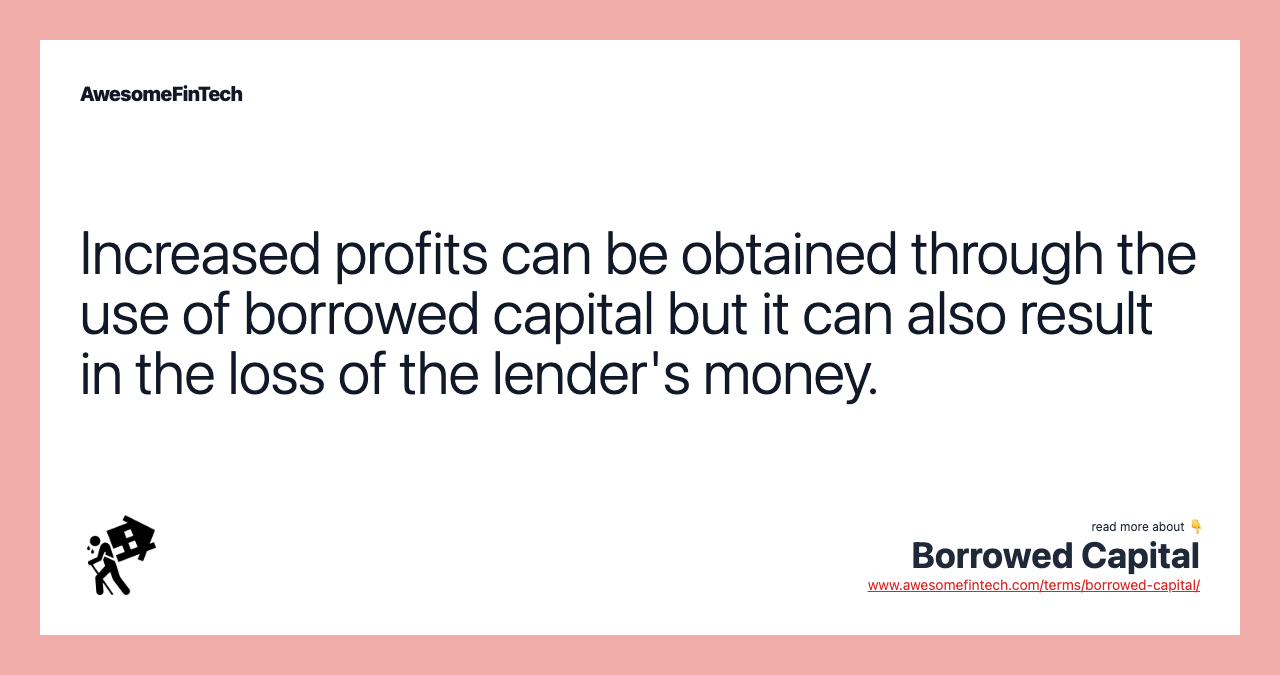Borrowed Capital
Borrowed capital consists of money that is borrowed and used to make an investment. So, the house, which is now an asset belonging to the homeowner, is acquired with both equity and debt, or borrowed capital, in the form of a mortgage. Equity capital is owned by the company and shareholders and is the opposite of borrowed capital. Borrowed capital can take the form of loans, credit cards, overdraft agreements, and the issuance of debt, such as bonds. Increased profits can be obtained through the use of borrowed capital but it can also result in the loss of the lender's money.

What Is Borrowed Capital?
Borrowed capital consists of money that is borrowed and used to make an investment. It differs from equity capital, which is owned by the company and shareholders. Borrowed capital is also referred to as "loan capital" and can be used to grow profits but it can also result in a loss of the lender's money.





Understanding Borrowed Capital
Businesses need capital to operate. Capital is wealth that is used to generate more wealth. For businesses, capital consists of assets — property, factories, inventories, cash, etc. Businesses have two options to acquire these: debt financing and equity financing. Debt is money that is borrowed from financial institutions, individuals, or the bond market. Equity is money the company already has in its coffers or can raise from would-be owners or investors. The term "borrowed capital" is used to distinguish capital acquired with debt from capital acquired with equity.
There are many different borrowing methods that constitute borrowed capital. These can take the form of loans, credit cards, overdraft agreements, and the issuance of debt, such as bonds. In all instances, a borrower must pay an interest rate as the cost of borrowing. Typically, debt is secured by collateral. In the case of a home purchase, the mortgage is secured by the house being acquired. Borrowed capital may also take the form of a debenture, however, and in that case, it is not secured by an asset.
Borrowed capital is commonly used in the economy whether that be for personal reasons or for business reasons. According to a Congressional Research Service report from 2019, almost 80% of small businesses in the U.S. relied on borrowed capital to operate their businesses. In 2018, small business loans amounted to $632.5 billion.
The upside of investing with borrowed capital is the potential for greater gains. The downside is the potential for greater losses, given that the borrowed money must be paid back somehow, regardless of the investment's performance.
Example of Borrowed Capital
To use an example from personal finance, when a person buys a home they typically make a down payment. The down payment comes out of their own wealth; their savings or proceeds from the sale of another house. If a home costs $300,000, their down payment would be $60,000, which is a 20% down payment; standard in the United States. The remaining cost of the house, $240,000 ($300,000-$60,000), would need to be borrowed.
The additional funds needed to purchase the house would come in the form of a mortgage loan from a bank. So, the house, which is now an asset belonging to the homeowner, is acquired with both equity and debt, or borrowed capital, in the form of a mortgage. The cost to borrow the $240,000 would come with a monthly interest rate that the homeowner would need to pay in addition to the principal installments of paying back the loan.
Related terms:
80-10-10 Mortgage
An 80-10-10 mortgage "piggybacks" a 10% home equity loan on top of a conventional 80% mortgage, leaving a 10% down payment. read more
Accounting
Accounting is the process of recording, summarizing, analyzing, and reporting financial transactions of a business to oversight agencies, regulators, and the IRS. read more
Capital : How It's Used & Main Types
Capital is a financial asset that usually comes with a cost. Here we discuss the four main types of capital: debt, equity, working, and trading. read more
Collateral , Types, & Examples
Collateral is an asset that a lender accepts as security for extending a loan. If the borrower defaults, then the lender may seize the collateral. read more
Debenture
A debenture is a type of debt issued by governments and corporations that lacks collateral and is therefore dependent on the creditworthiness and reputation of the issuer. read more
Debt Issue
A debt issue is a financial obligation that allows the issuer to raise funds by promising to repay the lender at a certain point in the future. read more
Debt Financing
Debt financing occurs when a firm raises money for working capital or capital expenditures by selling debt instruments to individuals and institutional investors. read more
Down Payment
A down payment is a sum of money the buyer pays at the outset of a large transaction, such as for a home or car, often before financing the rest. read more
Equity : Formula, Calculation, & Examples
Equity typically refers to shareholders' equity, which represents the residual value to shareholders after debts and liabilities have been settled. read more
Equity Financing
Companies seek equity financing from investors to finance short or long-term needs by selling an ownership stake in the form of shares. read more